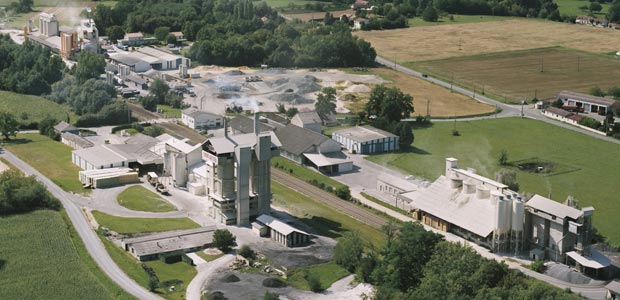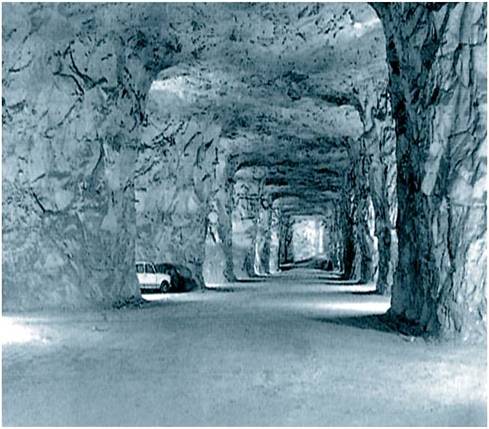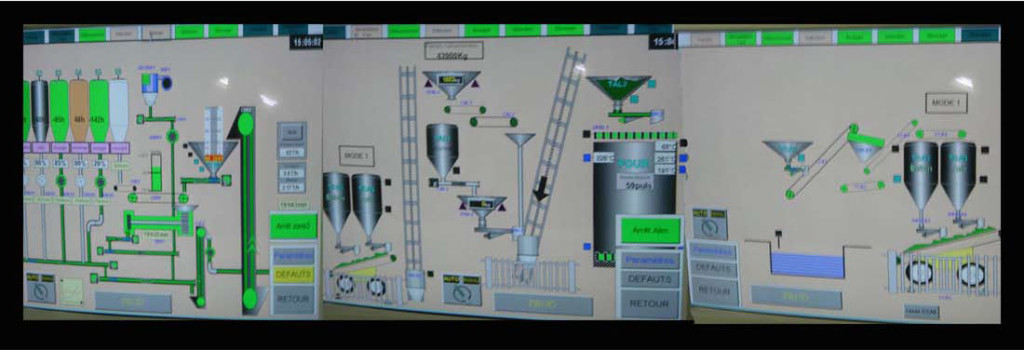St. Astier Natural Hydraulic Limes

Aerial Photo of St. Astier Production Plant
~ St. Astier Natural Hydraulic Limes (NHL) and derivative products have been produced by the same families since 1851. The mineralogical characteristics of the raw materials, the manufacturing process and the quality controls are such that users are assured of the constant performance of the products. The experience acquired over the years is shared with the user through the assistance available from the technical department and from carefully chosen specialist distributors, able to assess the type of lime finish, plaster or render required.
~ In new build, St. Astier Limes have developed a range of binders and ready mixed finishes combining all the characteristics required by today’s builder in terms of speed, setting, strength, elasticity, plasticity, low capillarity and shrinkage, with the breathability and aesthetic quality of lime finishes. The result is that these lime finishes are becoming the obvious alternative to cement finishes also in new build and eco build sectors.
~ The ecological benefits of Thermocromex such as CO2‚ re-absorption and condensation control provide vital answers to some of today’s environmental and energy saving requirements which cannot be ignored by the professions and trades involved in protection of the built heritage and in the construction of our new living environment.
~ St. Astier natural hydraulic lime finishes have been adopted in a number of countries and in the most diverse climatic conditions, from the Arctic Circle to the desert, from the marine locations to high mountain sites. They have been and are used on some of the most important world heritage sites, in vernacular and ordinary buildings, in reproducing the characteristics of ancient finishes as well as providing solutions to modern architectural finish requirements. The technical expertise at hand will also assist in achieving engineering solutions when an alternative to cement finishes is required.
~ The purpose of this website is to provide as much information as possible to the specifier and the user, so that correct choices can be made on scientific and practical bases. This information, together with the quality of the products and the co-operation and technical assistance of the manufacturer and its distributor network, are the main reasons of the success of St. Astier hydraulic limes worldwide.
![]()
The importance of the composition of St. Astier raw material and manufacturing method in the production of pure and natural hydraulic lime.
~ In 1833, Louis Vicat, still considered today one of the greatest authorities in hydraulic limes, surveyed the limestone quarries at St. Astier situated in Perigord area of Dordogne where archeological evidence shows that lime was produced in Roman times. Vicat concluded that the material was appropriate for the production of natural hydraulic lime. Industrial production begun in 1851. Today, St. Astier’s production capacity is over 100,000 tons per year.
~ The deposits extend between Montaceix and Neuvic sur l’Isle (approx. 6.2miles) and the layer is over three hundred and twenty eight feet thick. It was formed during the Upper Cretaceous period (approx. 75 million years ago) by marine sediment (mostly crustacean and corals). The sea in the basin was not subject to severe currents and this allowed the formation of a uniform and undisturbed layer of calcareous rock infiltrated mainly by silica with only insignificant traces of other elements. This characteristic of the rock is unique in Europe and is the reason why the St. Astier products are so reliable.
~ The composition of this calcareous rock infiltrated mostly by silica makes all the difference between producing materials with constant characteristics or being unsure of the final qualities as is commonly experienced when argillaceous or less pure limestone deposits are exploited.
![]()
The EU norms (EN/BS 459.1/2/3) on natural hydraulic lime.
~ The EU norms state that natural hydraulic lime is the product of burning and slaking limestone. It should not contain any additions such as pozzolans, gypsum, air entrainers, ash or cement. Where additions are present they will have to be qualified and the resulting products will have to be named as NHL-Z indicating additions of pozzolanic or hydraulic materials of up to 20%. The norm also allows up to 3% of SO3 content and between 3%-15% of free lime.
~ Although the distinction between pure NHL products and others, where additions have been introduced, is welcome, the opinion of many is that the tolerances given above are too wide and a possible result could be the use of non suitable materials.
~ Addition of pozzolanic and hydraulic material (cement being the most common) is clearly necessary in products derived from poor raw materials when hydraulic properties and other mechanical characteristics are not constant. The presence of these additions in some cases could be damaging and it is advisable to ask suppliers to state whether or not their products contain additions and, specifically, what has been added. In this case of SO3, the limit in the norm is considered too high whilst the limit for free lime is considered too low, again making possible the use of non suitable materials.
~ For their customer’s peace of mind, St. Astier Limes give the following figures for all their NHL products: no additions, only traces of SO3 (0.45%-0.54%) and between 15% to over 50% free lime.
~ Most important of all, the St. Astier NHL products are totally compatible and will not react with old finishes because they do not contain reagent components. Salts, which might be contained in the structure or have been introduced by previous unsympathetic interventions, will be allowed to migrate out of the structure without affecting the soundness of an NHL finish. Furthermore, interventions with NHL finishes are not irreversible and material recyclability is ensured.
![]()
The importance of raw materials

~ Limestone and argillaceous limestone that contains silica will also contain sulfates, alumina, iron, magnesium, manganese, potassium, and other compounds. Burning the limestone at temperatures above 1472°F (800°C) will combine the above components with the calcium carbonate forming calcium silicates, aluminates and ferrites. The ideal result would be to obtain a product containing the required value of combined silica with the lowest possible presence of potentially damaging other components such as tricalcium aluminate (C3A) and soluble sulfates.
~ Tricalcium aluminate starts occurring when materials are burned at 1652°F (900°C) and increases at 1832°F (1000°C) and over. The highest values are found in ordinary cement (sometimes over 10%). Obviously the lower the amount of alumina and sulfates contained in raw material, the better the final product quality. St. Astier deposits are exceptionally low in alumina and in sulfates. The resulting products are therefore virtually free of the components.
~ Ordinary cement finishes and finishes made with lime where cement has been added are sure to contain high quantity of tricalcium aluminate which in contact with sulfates and water can produce sulfate attack starting with efflorescence and progressing to damaging joints, brick and stone. The BS 5628 warns about this, but does not indicate that a simple solution could be if use of a pure NHL material. High presence of gypsum is also to be avoided. Its sulfate content can be disastrous.
![]()
Manufacturing process and control

~ The production process is extremely important to ensure that the final quality and performance of the products. St. Astier’s whole production, from rock extraction to packaging is fully automated and computer controlled. The coal used for burning is the purest anthracite coal. It is dosed in the required amount and mixed with the stone before introducing the charge into the furnace (vertical kilns of 200 T capacity). At the end of each burning, all batches are checked for CO2. The amount of CO2determines the efficiency of the burning and regulates the subsequent water addition during the slaking process.

~ Expansion tests (soundness) are also constantly made to ensure that no material with an expansion value over 1/16 of an inch (2mm) is processed further thus avoiding the use of sub standard material which would result in products subject to shrinkage and containing a high level of reactive quick lime.
~ Laboratory tests are conducted continuously to comply with EN 459 mandatory tests (fineness, free water content, soundness, bulk density, compressive strength, setting time, penetration, SO3 and available lime content). These, combined with other tests (tensile strength, elasticity moduli, workability, adhesion, whiteness), ensure the customer has access to the most comprehensive information allowing the correct choice of product to be safely made.
~ Apart from the virtual absence of soluble sulfates and tricalcium aluminate, directly due to the chemical composition of the natural stone, the sophisticated and controlled production process ensures that the correct amount of silica is combined in burning, to constantly achieve the required strength and hydraulic set with no need for additions of pozzolanic or other materials. This facilitates design and ensures that finishes are quickly resistant to frost and rain.
~ Excessive humidity or rain water will not stop the hardening process as in putties or air limes. In plastering, if good working practice is applied, jobs are completed efficiently and, in our experience, in considerably less time, reducing overall costs. Furthermore, the application season is extended to nearly the whole year and frost production is necessary for a shorter time than finishes made with lime putty. The production of various strength materials as NHL 5, 3.5, 2 (commonly defined as eminently, moderately and feebly hydraulic), reduces the need for blending.
~ The efficient slaking produces the pulverization of the burned lime to obtain very fine products (0.08mm) with low bulk density. Low density means large cost savings when mixes are made based on volume (on a 1:2 mix one needs only 305kg of NHL 3.5 per m³ of sand versus 675 kg of lime putty or 725kg of cement in an equivalent mix).
~ Mixed with the appropriate sand, NHL finishes will have approx 30% voids (versus 5% in cement based finishes). Calcite forming during carbonation will obstruct some of the voids, but cannot obstruct them all. This is the reason why NHL finishes, although water resistant, have excellent vapor exchange qualities (permeability to air) avoiding the risk of trapping condensation, which is common when cement based finishes are used.
~ NHL products retain a high percentage of available lime (15% to over 50%). This explains their workability, their ability to accept re-working if required and the presence of self-healing properties (re-working would also be impossible if cement or gypsum were present).
~ Furthermore, the absence of additions and the use of anthracite coal, which burns efficiently leaving little residue in the lime, gives St. Astier NHL products nearly a white appearance (whiteness index from 67-76). This means that it will be easier to reproduce the natural color of the sand used.
~ St. Astier NHL products are used worldwide for their quality and reliability and in the most varied climatic conditions. Innumerable buildings of all ages have been preserved and restored with these materials over the last 150 years. The St. Astier’s range of NHL products is available in the United States through/their responsibility is to assist in the task if selecting the most suitable materials, design, color matching, analysis of existing finishes, training and choosing the correct aggregates to use in the mixes, so essential to ensure optimal performance.
* For further guidance, please contact Southwest Progressive Enterprises.
